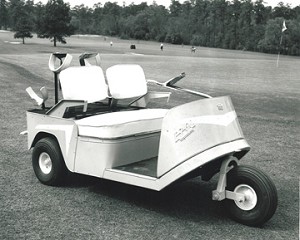History Of The Golf Car
The first gas-powered golf cars appeared just after Word War II and were used primarily for the disabled. With the development of the electric golf car by Merle Williams’ Marketeer Company in 1951, the race began to build a better mousetrap. Two additional companies began production of electric golf cars in 1954: LEKTRO and E-Z-GO. Cushman began production in 1955, Club Car in 1958, Taylor-Dunn in 1961, and Harley-Davidson in 1963. In 1971 the gas powered golf car made a comeback and soon after became a huge hit in a small town called The Villages, Florida.
The leading company in today’s market is E-Z-GO and has been owned by Textron since 1961. Founded by Beverly Dolan, who is also considered the Father of the Golf Cart, E-Z-GO started quite modestly with a $200 payment Mr. Dolan received upon his Army discharge. The next day he bought a surplus 24-volt electric motor used to power the wind flaps on a B-17 and hooked it up to a battery pack. Thus began an industry.
Over the years, golf cars have moved from the golf course to mainstream, and can be found on city streets, college campuses and inside shopping centers. They can also be found on racetracks and older models are sometimes tricked out with fancy coach and bodywork.
Ever since the National Highway Traffic Safety administration allowed “low speed vehicles” such as golf cars, to travel up to 25 mph on roads with speed limits up to 35 mph in 1998, golf cars have been slowly moving off the golf course and into people’s garages, with sales to individuals growing each year.
It is legal to drive a golf cart on some Minnesota roadways, but check with your local city hall to make sure that you’ve got the right license.



